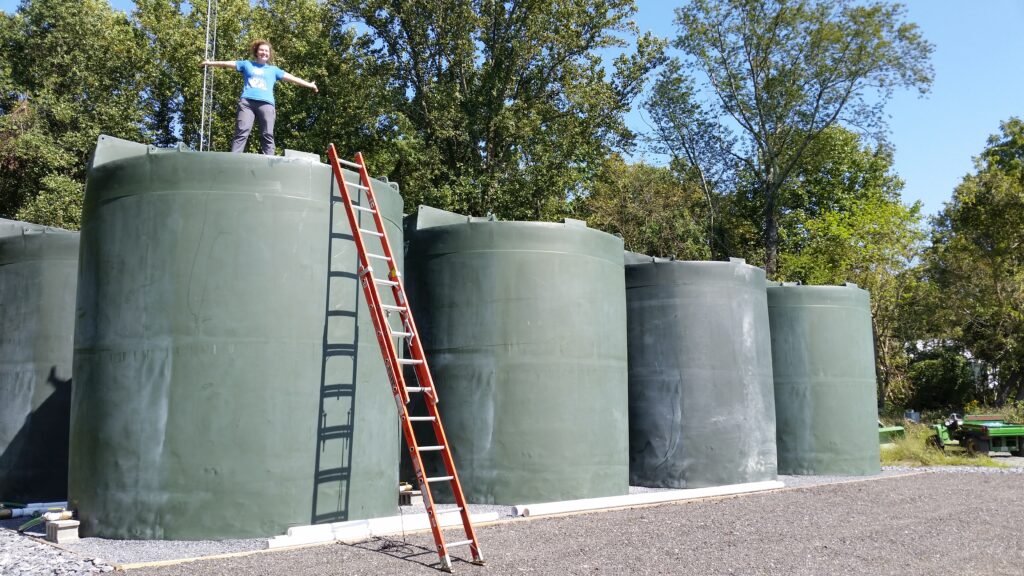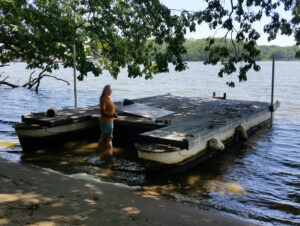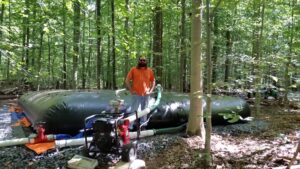by Aliya Uteuova

Postdoc Anya Hopple stands atop freshwater tanks for the new TEMPEST experiment. Each tank can hold 10,000 gallons of water, which will saturate forest soils to simulate heavy rainfall events. (Credit: Rick Smith)
Heavy rainfall and storm surges rank among the most common natural-weather events in the United States. They can occur in every state. They’re also one of the most widely felt impacts of climate change, making it impossible to ignore the economic and physical harm they leave in their wakes.
In a forest at the Smithsonian Environmental Research Center (SERC), scientists are working to uncover how sudden deluges could impact forests in decades to come. Called TEMPEST, the new experiment will mimic intense freshwater rainstorms and saltwater storm surges by inundating parts of the forest.

Postdoc Anya Hopple poses for a selfie by a filtration system, which will filter seawater from the Rhode River for one of the forest saturation experiments. (Photo: Anya Hopple)
Simulating a Storm
“No one has ever tried to assess the effect of storm surges on ecosystem ecology using an ecosystem-scale manipulation,” said Anya Hopple, postdoctoral researcher at the Pacific Northwest National Laboratory and visiting researcher at SERC.
“TEMPEST” stands for Terrestrial Ecosystem Manipulation to Probe the Effects of Storm Treatments. It’s a partnership between SERC, the Pacific Northwest National Laboratory (PNNL) and the U.S. Department of Energy. Two scientists from Global Aquatics Research LLC, Rick Smith and Stella Woodard, led the engineering and installation of the project.
The researchers will release 80,000 gallons of freshwater onto 2,000-square-meter forest plots, to mimic the effects of storms. That amount of water is equivalent to a 6-inch rain event over the course of 10 hours. To put that in perspective, average precipitation in Annapolis, just a few
miles from SERC, ranges from 3 to 4.5 inches per month. They’ll be simulating downpours that are extreme – yet already becoming more frequent.
In another forest plot nearby, they’ll repeat the experiment with saltwater. They’ll release the water through drip lines stretched across the forest plots, to saturate the soil. These simulations will occur two to four times per year and will continue for a decade.

These irrigation lines will saturate a SERC forest with 80,000 gallons of water to simulate extreme rainfall and storm surges. (Credit: Rick Smith)
Last fall the scientists carried out a full system test, drawing seawater from the nearby Rhode River, passing it through a filter and storing it in a large bladder. For the freshwater experiment, they trucked the water in and stored it in large 10,000-gallon tanks. They then used the freshwater to test the irrigation system that delivers water to the forest plots. They’ll start the freshwater storm simulations during summer 2021 and the seawater simulations in 2022.
Running the TEMPEST experiment in SERC forests allows the scientists to gather real-time data and track it on site. They’re also using continuous infrared gas analyzers to measure fluxes of greenhouse gases like carbon dioxide, methane and nitrous oxide.
Stressed Out By Salt?

Stella Woodard, who helped engineer and install TEMPEST, stands beside a barge being modified to take in Rhode River seawater. (Credit: Rick Smith)
Coastal forest ecosystems are incredibly important to the global carbon cycle. They also provide habitat, which is why scientists are striving to understand how extreme storms will affect them. Scientists hypothesize that over time, experimental storm surges, just like natural ones, could spell trouble for trees and other plants.
Saltwater surges could be especially problematic.
“We think the saltwater effect will be minor at first until a tipping point, when it will dramatically increase the tree mortality rate,” said Patrick Megonigal, head of the Biogeochemistry Lab at SERC. The lab is perhaps best known for the Global Change Research Wetland. Launched in 1987, it contains the world’s longest-running field experiment on how carbon dioxide impacts plant communities.

Rick Smith stands beside a 20,000gallon rubber bladder set up in the forest for storing seawater. (Photo courtesy of Rick Smith)
Adding salt onto freshwater forests could stress the trees and gradually affect their physiology. That in turn might make it difficult for them to photosynthesize and acquire the nutrients essential for their survival.
“Certain types of vegetation and trees are equipped to exist and thrive in really [salty] conditions,” Hopple said. Mangrove trees, for example, can exclude salt from their roots and excrete it from their leaves. “But freshwater vegetation does not have the same mechanisms of coping.”
Scientists expect the short-term responses to be smaller. Since they’re continuously monitoring the forest plots to avoid excessive stress, it’s possible the plants will be resilient enough to survive brief exposures to excess water and salt. But the more frequently these extreme storm events occur, the more those impacts could build up. They could reach a point where the flora become so stressed, they no longer recover.
Eventually Hopple hopes to take data from TEMPEST and churn it into mathematical models, which could predict how other forests might respond to extreme weather.
“This would allow us to understand and anticipate what’s going to happen decades from now, or what may be happening right now,” she said.

